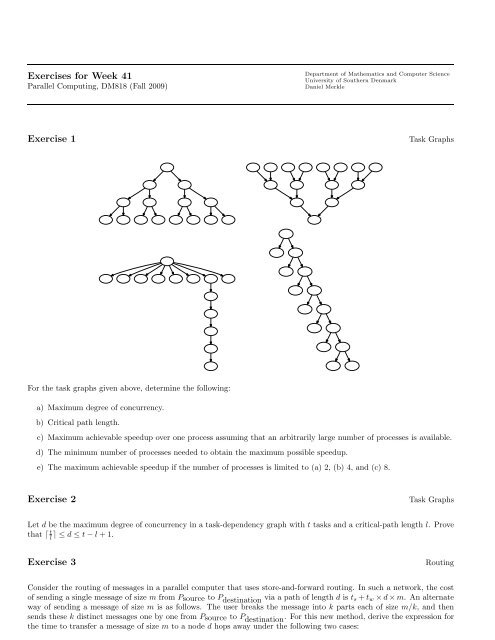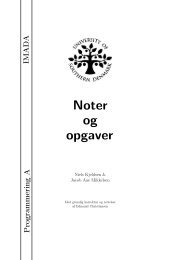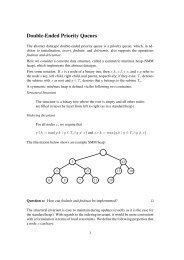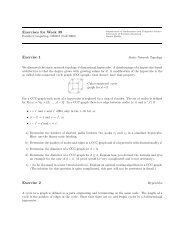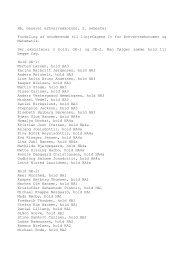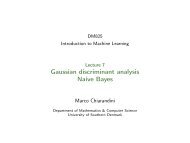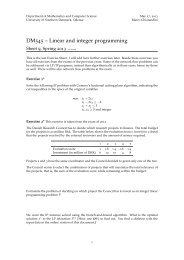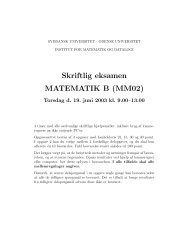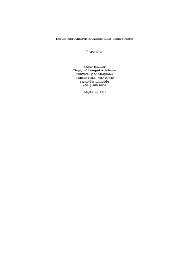Exercises for Week 41 Exercise 1 Exercise 2 Exercise 3
Exercises for Week 41 Exercise 1 Exercise 2 Exercise 3
Exercises for Week 41 Exercise 1 Exercise 2 Exercise 3
You also want an ePaper? Increase the reach of your titles
YUMPU automatically turns print PDFs into web optimized ePapers that Google loves.
<strong><strong>Exercise</strong>s</strong> <strong>for</strong> <strong>Week</strong> <strong>41</strong><br />
Parallel Computing, DM818 (Fall 2009)<br />
Department of Mathematics and Computer Science<br />
University of Southern Denmark<br />
Daniel Merkle<br />
<strong>Exercise</strong> 1<br />
Task Graphs<br />
For the task graphs given above, determine the following:<br />
a) Maximum degree of concurrency.<br />
b) Critical path length.<br />
c) Maximum achievable speedup over one process assuming that an arbitrarily large number of processes is available.<br />
d) The minimum number of processes needed to obtain the maximum possible speedup.<br />
e) The maximum achievable speedup if the number of processes is limited to (a) 2, (b) 4, and (c) 8.<br />
<strong>Exercise</strong> 2<br />
Task Graphs<br />
Let d be the maximum degree of concurrency in a task-dependency graph with t tasks and a critical-path length l. Prove<br />
that ⌈ t l ⌉ ≤ d ≤ t − l + 1.<br />
<strong>Exercise</strong> 3<br />
Routing<br />
Consider the routing of messages in a parallel computer that uses store-and-<strong>for</strong>ward routing. In such a network, the cost<br />
of sending a single message of size m from Psource to P destination via a path of length d is t s + t w × d × m. An alternate<br />
way of sending a message of size m is as follows. The user breaks the message into k parts each of size m/k, and then<br />
sends these k distinct messages one by one from Psource to P destination . For this new method, derive the expression <strong>for</strong><br />
the time to transfer a message of size m to a node d hops away under the following two cases:
a) Assume that another message can be sent from Psource as soon as the previous message has reached the next node<br />
in the path.<br />
b) Assume that another message can be sent from Psource only after the previous message has reached P destination .<br />
For each case, comment on the value of this expression as the value of k varies between 1 and m. Also, what is the optimal<br />
value of k if t s is very large, or if t s = 0?<br />
<strong>Exercise</strong> 4<br />
Task Dependency Graph<br />
A =<br />
<br />
<br />
<br />
<br />
<br />
<br />
<br />
<br />
<br />
<br />
<br />
<br />
B =<br />
<br />
<br />
<br />
<br />
<br />
<br />
<br />
<br />
<br />
Given are the two sparse matrices A and B. Consider the problem of sparse matrix-matrix multiplication. A dot<br />
corresponds to a non-zero entry. The computation is decomposed into 8 tasks. Let task i the owner of row A[i, ∗] and of<br />
row B[i, ∗]. Task i has to compute row i of the result C = A · B.<br />
a) Draw the task interaction graph using directed edges. Draw an edge from task T i to task T j , if T i requires data from<br />
T j .<br />
b) Suppose that task i owns column i of matrix B instead of row i <strong>for</strong> the computation. Draw the task-interaction<br />
graph <strong>for</strong> this case.<br />
<strong>Exercise</strong> 5<br />
⎛<br />
⎝<br />
⎞<br />
A 1,1 A 1,2 A 1,3<br />
A 2,1 A 2,2 A 2,3<br />
⎠ →<br />
A 3,1 A 3,2 A 3,3<br />
⎛<br />
⎞ ⎛<br />
L 1,1 0 0<br />
⎝ L 2,1 L 2,2 0 ⎠. ⎝<br />
L 3,1 L 3,2 L 3,3<br />
⎞<br />
U 1,1 U 1,2 U 1,3<br />
0 U 2,2 U 2,3<br />
⎠<br />
0 0 U 3,3<br />
LU factorization<br />
1: A 1,1 → L 1,1 U 1,1 6: A 2,2 = A 2,2 − L 2,1 U 1,2 11: L 3,2 = A 3,2 U −1<br />
2,2<br />
2: L 2,1 = A 2,1 U −1<br />
1,1<br />
7: A 3,2 = A 3,2 − L 3,1 U 1,2 12: U 2,3 = L −1<br />
2,2 A 2,3<br />
3: L 3,1 = A 3,1 U −1<br />
1,1<br />
8: A 2,3 = A 2,3 − L 2,1 U 1,3 13: A 3,3 = A 3,3 − L 3,2 U 2,3<br />
4: U 1,2 = L −1<br />
1,1 A 1,2 9: A 3,3 = A 3,3 − L 3,1 U 1,3 14: A 3,3 → L 3,3 U 3,3<br />
5: U 1,3 = L −1<br />
1,1 A 1,3 10: A 2,2 → L 2,2 U 2,2<br />
Given is the decomposition of the LU factorization into 14 tasks. (We assume that each of the 14 tasks requires the same<br />
unit amount of work).<br />
a) Draw the task dependency graph.<br />
b) Determine all critical paths.<br />
c) Determine the average and the maximal degree of concurrency.<br />
d) Describe/draw an efficient mapping of the task-dependency graph of the decomposition onto three processes.<br />
e) Describe/draw an efficient mapping of the task-dependency graph of the decomposition onto four processes.<br />
f) Which of the both mappings solves the problem faster?<br />
g) What is the maximal speedup that can be achieved and how many processes are necessary <strong>for</strong> that speedup? (to be<br />
discussed next quarter)
h) What is the maximal efficiency, that can be achieved, if p > 1 processes are used? Describe/draw the mapping that<br />
you used. (to be discussed next quarter)<br />
<strong>Exercise</strong> 6<br />
Task Dependency Graph<br />
Given is the following task dependency graph:<br />
1<br />
2 2<br />
3 3 3<br />
... ... ... ...<br />
n−1<br />
n−1<br />
...<br />
n−1<br />
n−1<br />
...<br />
n n n n n n<br />
a) Determine the maximal degree of concurrency.<br />
b) What is the length of the critical path?<br />
c) Determine the average degree of concurrency.<br />
<strong>Exercise</strong> 7<br />
Circular q-shift<br />
Show that in a p-node hypercube, all the p data paths in a circular q-shift are congestion-free if E-cube routing (Section<br />
4.5 of the course book) is used.<br />
Hint: (1) If q > p/2, then a q-shift is isomorphic to a (p − q)-shift on a p-node hypercube. (2) Prove by induction on<br />
hypercube dimension. If all paths are congestion-free <strong>for</strong> a q-shift (1 ≤ q < p) on a p-node hypercube, then all these paths<br />
are congestion-free on a 2p-node hypercube also.<br />
<strong>Exercise</strong> 8<br />
Circular q-shift<br />
Show that the length of the longest path of any message in a circular qshift on a p-node hypercube is log p − γ(q), where<br />
γ(q) is the highest integer j such that q is divisible by 2 j .<br />
Hint: (1) If q = p/2, then γ(q) = log p − 1 on a p-node hypercube. (2) Prove by induction on hypercube dimension. For a<br />
given q, γ(q) increases by one each time the number of nodes is doubled.


